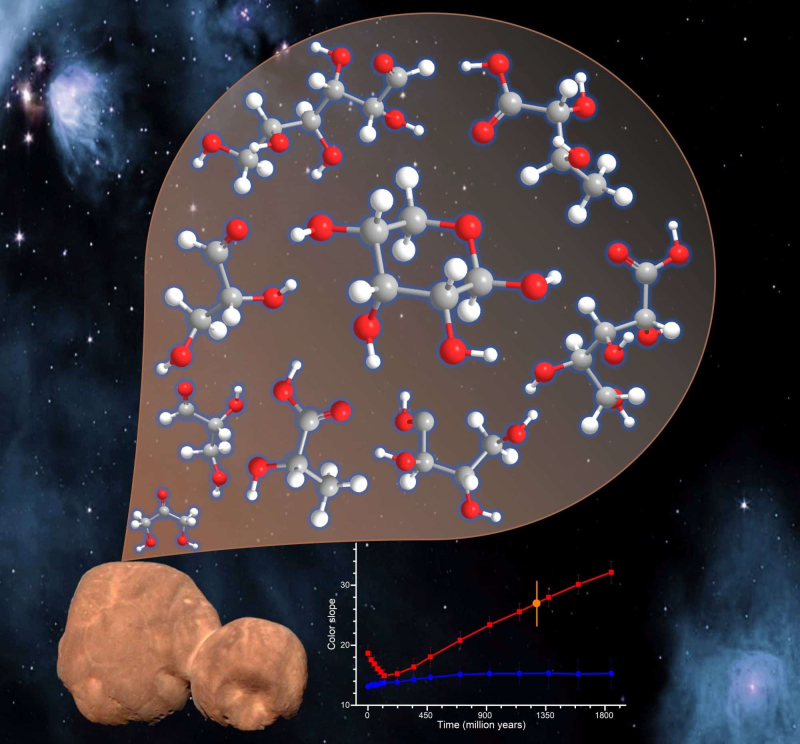Follow us on Google News (click on ☆)
Arrokoth—the most distant object ever observed by a space probe—reveals a complex surface chemistry resulting from the interaction between cosmic radiation and matter, leading to the formation of essential sugars that are the building blocks of life. This is suggested by a study published in PNAS and conducted by chemists from CNRS in collaboration with American scientists.

By bombarding frozen methanol samples with simulated cosmic rays, it is possible to reproduce the unusual color of Arrokoth and, in doing so, identify sugar molecules, including ribose and glucose.
© Cornelia Meinert
In 2019, the New Horizons space probe* flew past a strange object at the edge of our solar system: a blurry shape resembling a reddish snowman. Arrokoth has since revealed itself to be a fascinating celestial body located in the region of the solar system beyond Neptune's orbit, known as the Kuiper Belt. Preserved from the turmoil and frequent collisions that affect areas closer to the Sun, this cold and silent world has much to teach us about the formation of the solar system 4.6 billion years ago.
Once the precious observations from the New Horizons probe were returned to Earth, many scientists around the world analyzed them to try to determine the age, composition, and formation process of the most primitive object ever visited by a space probe.
Arrokoth is believed to have appeared over 4 billion years ago following the non-collisional gathering of two bodies formed in the early years of the solar system from a cloud of celestial dust. Its surface reveals complex chemistry devoid of water but rich in frozen methanol. As for the reddish coloration of this mysterious celestial body, scientists are still wondering. Could it be the result of a particular interaction between light and matter in this icy world?
This is suggested by a study recently published in the Proceedings of the National Academy of Sciences. A team from the Institute of Chemistry of Nice (CNRS/Université Côte d'Azur), in collaboration with researchers from the University of Hawaii and the South West Research Institute, simulated the effects of galactic cosmic rays on methanol ices under temperature and pressure conditions mimicking those experienced by Arrokoth in the depths of space.
The results are surprising: methanol ices exposed to cosmic radiation reproduce Arrokoth's distinctive color. But the discoveries don't stop there! Analysis of the organic compounds formed under irradiation reveals a true treasure trove of molecules, including the formation of sugars such as ribose and glucose—molecules essential to the building blocks of life. Aromatic hydrocarbons are believed to be responsible for the ultra-red slopes observed on Arrokoth's surface.
These discoveries have profound implications for understanding the evolution of the primitive solar system and the question of potential life beyond Earth. Arrokoth, as an intact relic of the ancient past, offers a unique window into the processes that governed the formation of celestial bodies.
Elucidating its chemical composition provides new insights into the complex interaction between chemistry and radiation during the cosmic processes governing the evolution of planetary surfaces. A new stage in our journey through the cosmos, exploring the wonders of our celestial neighborhood and beyond.
Note:
*New Horizons is a probe from the American space agency (NASA) launched in 2006 with the primary objective of studying the dwarf planet Pluto and its satellites. In addition to these observations, which have since dramatically altered our understanding of Pluto, it passed 2,175 miles (3,500 km) from Arrokoth in 2019.
Writer: AVR
Reference:
Ionizing radiation exposure on Arrokoth shapes a sugar world
Chaojiang Zhang, Vanessa Leyva, Jia Wang, Andrew M. Turner, Mason Mcanally, Ashanie Herath, Cornelia Meinert, Leslie A. Young & Ralf I. Kaiser.
PNAS 2024
DOI: https://doi.org/10.1073/pnas.2320215121